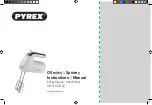
7
Revision C • 12/05
H
A
R
R
I
S
C
O
R
P
O
R
A T
I
O
N
When an unbalanced device must connect to a SMX
d bal-
anced analog output, and an IHF-PRO match box is not avail-
able, do not tie the low (-) and shield pins together to “unbal-
ance” the signal. Leave the low output pin “floating” when un-
balancing a SMX
d output, as shown in the following illustra-
tion.
Digital Audio Inputs & Outputs
The 3-pin AMP MOD IV digital audio connector pinouts
(shown at right, above) are pinned the same as those used on
the BMX
digital and RMXdigital consoles.
The digital inputs are J13 (Input 5), J14 (Input 6), and J15
(Input 7). The digital outputs are J16 (PGM 1), J17 (PGM 2),
and J18 (Mix-Minus).
The SMX
d digital inputs can also handle most S/PDIF digi-
tal signals when a 249 ohm resistor is installed at the SMX
d
connector housing to load the 75 ohm S/PDIF cable. An un-
balanced-to-balanced line transformer could alternately be
used to interface an S/PDIF signal.
Note 1:
A signal conversion interface must be used to con-
nect an AES/EBU output to a S/PDIF input.
Note 2:
Some S/PDIF signals may not work with the SMX
d’s
inputs, even with the additional load resistor or a transformer,
due to nonstandard levels or protocols used by the device with
the S/PDIF output.
SMXd
Balanced
Output
3
2
1
6
5
4
To the
Unbalanced
Device
R
L
Shields
Connecting an Unbalanced Device
to a MOD IV Analog Output
(Nominal Output is -2 dBu)
(Make no connections to pins 2 & 5)
Connecting an S/PDIF Device to
a MOD IV AES/EBU Input
249 ohm resistor
From
S/PDIF
Device
SMXd
AES/EBU
Input
Signal
Shield
3
2
1
Pinouts for Digital Input
and Output Connectors
High (+)
Low (-)
Shield
3
2
1
(wire insertion end view)
ANALOG INPUTS
DIGITAL INPUTS &
OUTPUTS
POWER SUPPLY
CONNECTION
START PULSE
OUTPUTS & TIMER
RESET OUTPUT
ANALOG OUTPUTS
C/R WARNING
& TALKBACK LOGIC
CHANNEL 1
MIC LOGIC
ANALOG INPUTS LEVEL
DIPSWITCHES
SMXD REAR PANEL CONNECTIONS




























